Vol 3 No. 31 TROPIC LIGHTNING NEWS July 29, 1968
Index
Three Civilians Survive VC Dungeon
By SP4 CHARLES HAUGHEY
3D BDE - Three weary and bleeding
Vietnamese surrendered to troops of Alpha Company, 2d Battalion, 12th Infantry
west of the 3d Brigade, 25th Infantry Division base camp at Dau Tieng.
They told a harrowing tale of living as VC captives for more than 8 weeks.
The trio, a woman of about 30, a man of 25 and a 16 year old boy
were first spotted sneaking along an overgrown trail through the deer shade of
rubber trees.
“When they saw us they threw up their hands and walked toward
us. They looked pretty scared,” said 2d Platoon leader Platoon Sergeant
Nat Taylor of New York City.
“They were stark white,” commented Company Commander 1st
Lieutenant Howard Renker of Ansonia, Connecticut. “Their clothing was
heavily blood-stained, all three bore numerous shrapnel wounds. Their
ankles were very swollen and bruised.”
The woman carried a small sack of clothes. The man offered
two hand- wrought leg irons which, he said, had caused the injured ankles.
“VC kill! VC kill!” The boy shook as he repeated this
phrase, pointing down the trail from the direction they had come.
Moments later, through an interpreter, and between gulps of hot
food and puffs on American cigarettes, the Vietnamese civilians told this story.
Each of them had been taken singly from widely separated
villages. “I have been imprisoned for 58 days “ said the woman.
“The first two weeks I was alone, then they brought the others into the
bunkers.”
The long weeks, with only bad rice to eat, were spent entirely
underground. “Most f the time our legs were shackled together,” they
said, demonstrating the heavy leg irons.
“We were threatened with beatings and death and often questioned
about ARVNs and Americans.”
Once, when their underground cell became flooded by heavy rains,
the prisoners were removed and directed to another hole.
As the medics, under the direction of Senior Medic Specialist 5
James R. Baker of Elkton, Md., cleaned and dressed their wounds, the three told
of their escape.
“Early this morning we heard many explosions, very close, and one
of the VC came to the hole and said, “Many, many G.I.s. Do not come out.
You will be shot! The guard left and we sat quietly for a long time.”
It later became apparent to the Americans that the “Many, many
G.I’s” were the forces of Bravo Company of the same battalion who had
earlier made contact with Cong elements along the perimeter of the enemy
positions where the civilians were being held. Bravo had halted and called
for artillery which had been quickly supplied by the 2d Battalion, 77th
Artillery in Dau Tieng.
The man had finally crawled to the exit and looked out. “A
Viet Cong about 20 meters away shot at me with an AK47! “ he said. “A
few moments later a Chicom grenade dropped into the tiny room and
exploded. We were all wounded.”
The three said they had waited about an hour before crawling out
and fleeing into the rubber trees.
“The alert actions of Bravo company and the bombardment of 105mm
rounds were responsible for driving the enemy from the area,” commented 2d
Battalion, 12th Infantry Operations Officer, Major D. MacLean of South
Dartmouth, Mass.
July 4th Attack Repulsed
By SP4 BILL SLUIS
3D BDE - More than 400 enemy rocket
and mortar rounds and a pair of pre-dawn ground attacks by two reinforced Viet
Cong companies were repelled by 3d Brigade, 25th Infantry Division soldiers on
the 4th of July.
The attack, largest sustained in the two-year history of Dau Tieng
base camp, was broken by gunships and infantry. At least 10 enemy soldiers
were left dead on the perimeter of the camp.
The attack began shortly before 2:30 a.m. as salvo after salvo of
mortar fire struck all corners of the base camp.
Miraculously, no one was killed as an official total of 374
mortars, eight 107mm rockets, and 25 RPG rocket rounds slammed around
infantrymen who were huddled in defensive bunkers.
Striking from both sides of the perimeter north of the airfield,
the Viet Cong, arrayed in suicide squads, attempted a ground wave pincer
movement which hit night defensive positions of the 2d Battalion, 77th
Artillery, and the 3d Battalion, 22d Infantry.
Several artillery bunkers were damaged as the enemy suicide squad,
hitting the west side of the camp, struck with RPG rocket rounds and satchel
charges. At least seven VC broke inside the perimeter before the attack
was halted.
On the east side of the camp, a larger Viet Cong force emerged from
behind tombstones in a cemetery but were cut down in a welter of machine gun and
duster fire. Two VC planted themselves near the end of the runway and
tossed pressure-released satchel charges onto the east end of the airstrip.
As gunships scrambled and shattered the air with a deafening roar
of fire, the ground wave attacks were completely disrupted. By the light
of flares, enemy soldiers were seen to toss their weapons to the ground and run
for the protective cover of nearby woods.
Before dawn, an AC-47 “Puff the Magic Dragon” aircraft began
circling the base camp, dropping flares and adding further firepower to the
assault on the retreating enemy. Artillery fire and more gunship raids
also rained down on the attackers.
A preliminary search of the perimeter the following morning
recovered, in addition to the enemy bodies, 434 home-made satchel charges, three
bangalore torpedoes, a dozen RPG-7 rocket rounds, 49 RPG-2 rounds, 45 60mm
mortar rounds, one RPG-2 launcher, numerous hand grenades and six AK-47 assault
rifles.
Blood trails leading away from the base camp indicated additional
enemy deaths which could not be positively confirmed. American casualties
numbered five dead, all in defense of the west perimeter, and 53 injured, 18 of
whom required hospitalization.
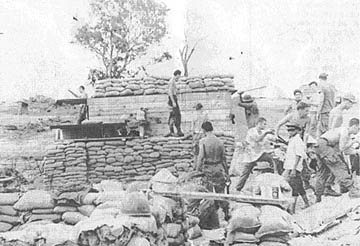 |
REPAIRING THE BUNKER LINE at Dau Tieng Base Camp, GIs with the help of Vietnamese nationals reinforce the positions. The west perimeter of the base camp came under heavy ground attack in the predawn hours of July fourth by two reinforced NVA companies. (Photo by SP4 Bill Sluis) |
Commander Gets In on the Action
3D BDE - Seven NVA soldiers died at
the hands of a 3d Brigade, 25th Infantry Division battalion commander firing
from his command helicopter.
Lieutenant Colonel Roy K. Flint of St. Petersburg, Fla., Commander
of the 3d Battalion. 22nd Infantry, used an M-l rifle and two hand grenades to
kill the NVA in rice paddies six miles northwest of Saigon.
The enemy soldiers had been pinned down while LTC Flint and his
pilot, Captain Jerry R. Pierce of Celoron, N.Y., strafed the area.
Dropping down to 100 feet, LTC Flint and his pilot spotted one man fleeing along
a canal line. Flint blasted away, unsure whether he got the enemy.
“I looked to one side and saw several shadow-like shapes creeping
in water in an old bomb crater,” Flint said. Quick investigation found
them to be enemy troops trying to hide. LTC Flint fired away all his
remaining ammo, killing three of them.
After the action, which took less than 20 minutes, members of
Charlie Company turned up four AK-47 assault rifles and two RPG rocket
launchers, including one that was loaded and ready to fire.
Dragons Slash VC Terrorists To Assist Plagued
Village
By SP4 Larry Weist
1ST BDE - Terrorist activity was
brought to a halt by a 25th Infantry Division rifle platoon after a six-hour
fire fight in a village the Viet Cong were using as a shield.
Viet Cong terrorists had killed the village chief and two others
the day before. As a result, the 1st Platoon of Company A, 2d Battalion,
14th Infantry, set up near the village.
During the night-long battle that began when the communists fired
on the platoon’s perimeter with RPG’s and automatic weapons, the Dragons
killed two enemy. During a sweep through the area the next morning, the
Americans detained 13 suspected Viet Cong.
“I was just getting ready to check the bunker line when
everything broke loose,” stated Sergeant Samuel Whitt, the platoon
sergeant. “We immediately returned fire with everything we had,” added
Whitt from Belvedere, S.C.
One of the loudest voices heard during the fight was the .50
caliber machine gun manned at the bunker of 1st Lieutenant Alastair Brown, the
platoon leader.
“Charlie didn’t expect us to have anything like this fifty out
here with us, I know it made him think twice before trying to move closer to us,”
said Brown of Long Island City, N.Y.
Artillery and helicopter gunships were called in to provide fire
support and illumination for the night battle.
“An illuminating round had just started to burn overhead
revealing the position of a Viet Cong moving directly toward us. We opened
up on him and he dropped out of sight,” said Private First Class Clayton
Bryant of Jay, Okla.
Early the next morning Bravo Company arrived and conducted a search
of the area that resulted in finding two bodies and the detention of 13
suspects.
Page 2 TROPIC LIGHTNING NEWS July 29, 1968
Decorated
| SILVER STAR | |
|
LTC Billy Leathers, HHB, 7th Bn, 11th Arty CPT Robert J. Falabella, HHC, 1st Bn, 5th Inf CPT William Shaffer, C Trp, 3d Sqdn, 4th Cav 1LT Dennis R. Adkins, Co C, 3d Bn, 22d Inf |
SFC Dale E. Brown, Co B, 2d Bn, 34th Armor SSG Freddie C. Faulkner, Co A, 2d Bn, 22d Inf SGT Thomas L. Finch, Co C, 1st Bn, 5th Inf |
|
BRONZE STAR MEDAL (HEROISM) |
|
|
LTC John H. Tipton, Hq, 2d Bn, 34th Armor MAJ Travis W. White, HHC, 2d Bn, 34th Armor CPT Robert Hemphill, Co B, 3d Bn, 22d Inf CPT Franklin D. Shiplett, HHC, 4th Bn, 23d Inf CPT William A. Coleman, HHC, 1st Bn, 27th Inf CPT Denneth D. McArthur, B Btry, 7th Bn, 11th Arty 1LT John J. Ricca, HHSB, 7th Bn, 11th Arty 1LT Louis M. Rundio, B Btry, 7th Bn, 11th Arty 1LT John J. McClelland, Co B, 2d Bn, 34th Armor 1LT Harold V. Metzger, Co B, 1st Bn, 5th Infantry 1LT Donald 1. Fields, HHC, 2d Bn, 34th Armor 1LT James P. Pinto, C Trp, 3d Sqdn, 4th Cav 1LT Oscar J. Harris, Co C, 2d Bn, 22d Inf 2LT Vernon H. Sorgee, Co B, 2d Bn, 34th Armor SGM Reuben J. Fuller, HHC, 1st Bn, 27th Inf SSG Frank Schlecht, B Btry, 7th Bn, 11th Arty SSG Aaron Thompson Jr., C Trp, 3d Sqdn, 4th Cav SSG Marvin D. Harris, A Btry, 3d Bn, 13th Arty SSG George L. Bryant, C Btry, 7th Bn, 11th Arty SSG Willie Mathis, C Btry, 7th Bn, 11th Arty SSG Roy J. Alexander, C Btry, 7th Bn, 11th Arty SSG Charles Nathan, Co B, 2d Bn, 34th Armor SSG John T. Hreha, Co B, 2d Bn, 34th Armor SGT Robert F. Jusza, Co B, 1st Bn, 5th Inf SP5 David Zatowski, Co B, 1st Bn, 27th Inf SP5 Robert Osborne, B Btry, 7th Bn, 11th Arty SGT Donald T. Hutsell, C Btry, 7th Bn, 11th Arty SGT Herbert W. Holland, HHC, 1st Bn, 27th Inf SGT Charles L. Sweatt, C Btry, 7th Bn, 11th Arty SGT Bobby L. Mayhew, Co B, 4th Bn, 23d Inf SP5 John E. Deardeuff, Trp B, 3d Sgdn, 4th Cav SP5 Roger W. Pritchard, Co D, 2d Bn, 27th Inf SGT Edward A. Reeves, C Btry, 3d Bn, 13th Arty SP5 James H. Muenster, Co B, 2d Bn, 34th Armor SP5 David L. Crutcher, C Btry, 3d Bn, 13th Arty SGT James T. Mc Innis, C Btry, 3d Bn, 13th Arty SGT Carson G. Culleton, Co A, 2d Bn, 12th Inf SGT Roger J. Whitaker, HHC, 1st Bn, 27th Inf SGT Howard Craig, HHC, 1st Bn, 5th Inf SP5 Carroll E. Tracy, Co B, 2d Bn, 34th Armor SP5 James H. Mc Neil, Co B, 2d Bn, 34th Armor SGT Jon D. Wrentmore, Co D, 2d Bn, 27th Inf |
SP4 Charles L. Easterwood, Co D, 2d Bn, 27th Inf SP4 Donald J. Brock, C Btry, 3d Bn, 13th Arty SP4 Ronald C. Kramer, Co B, 1st Bn, 5th Inf SP4 Terry L. Wray, Co B, 2d Bn, 34th Armor SP4 David L. Shortnacy, HHC, 1st Bn, 5th Inf SP4 Ronald N. Boyd, A Trp, 3d Sqdn, 4th Cav SP4 Stanley B. Anderson, HHC, 1st Bn, 5th Inf SP4 Randall J. Berdell, Co B, 1st Bn, 5th Inf CPL Anthony A. Tonogan, C Btry, 7th Bn, 11th Arty SP4 Harry B. Swiencki, D Trp, 3d Sqdn, 4th Cav SP4 Robert S. Mack, HHC, 1st Bn, 27th Inf SP4 Patrick A. Devanie, C Trp, 3d Sqdn, 4th Cav SP4 Burton H. Haugen, Co B, 4th Bn, 9th Inf SP4 Dennis C. Wagner, Co B, 4th Bn, 9th Inf SP4 Joseph E. Campbell, Co B, 1st Bn, 5th Inf SP4 Celso D. Cendan, HHC, 1st Bn, 27th Inf SP4 Frank R. Langford, HHC, 1st Bn, 27th Inf SP4 James L. Kopra, Co C, 2d Bn, 27th Inf SP4 Matthew Morzek, C Btry, 7th Sn, 11th Arty SP4 Peter M. Holt, Co A, 2d Bn, 22d Inf SP4 Carroll R. Lambert, Co A, 2d Bn, 22d Inf SP4 Daniel F. Oberding, HHC, 1st Bn, 5th Inf SP4 Richard John, C Trp, 3d Sqdn, 4th Cav SP4 Sherman E. Piggott, HHC, 1st Bn, 27th Inf PFC James T. Bailey, HHC, 1st Sn, 27th Inf PFC Barry Tannenbaum, Co A, 4th Bn, 23d Inf PFC George J. Nick, HHC, 1st Bn, 27th Inf PFC Dan V. Lindholm, HHC, 1st Bn, 27th Inf PFC Kenneth Corley, HHC, 1st Bn, 27th Inf PFC Arthur Ostrov, Co C, 4th Bn, 9th Inf PFC Donald R. Riggs, C Btry, 7th Sn, 11th Arty PFC Clofford Jackson, Co C, 2d Bn, 27th Inf PFC Layton Ferguson, Co C, 2d Bn, 27th Inf PFC Daniel P. Gonzales, Co C, 2d Bn, 27th Inf PFC Michael S. Salaices, Co A, 1st Bn, 5th Inf PFC Roger Kidd, Co B, 2d Bn, 34th Armor PFC Lorentz M. Larsen, Co B, 2d Bn, 34th Inf PFC Jeffrey V. Teger, HHC, 4th Bn, 23d Inf PFC Charles D. Leroy, C Btry, 7th Bn, 11th Arty PFC Gary Kirkpatrick, Co C, 2d Bn, 27th Inf PFC Gernette Carpenter, Co C, 2d Bn, 27th Inf |
Army Enlisted Men Eligible For 150-Day Drop on Hitch
U.S. Army enlisted men returning from a short tour area now are
eligible to be released from active duty up to 150 days prior to completion of
their normal terms of service. Previously, the maximum early release time
was 90 days.
In announcing the change, which became effective July 1, the
Department of the Army said the new policy is aimed at reducing the turnover
rate of individuals assigned to units in the United States.
Most soldiers who return from short tour areas for release from
active duty are with their units in the United States too short a period of time
prior to separation to justify their retention on active duty.
Enlisted personnel in a hostile fire zone may voluntarily extend
their tour in an overseas command to qualify for the 150 day early separation.
This would permit the Vietnam veteran to be released as soon as he completes the
extension of his Vietnam tour.
In short tour areas, except for hostile fire zones, an enlisted man
whose tour expires 151 to 180 days prior to his completion of service will be
retained in the overseas command until he has less than five months remaining
for completion of service.
He will then be returned to the United States for early separation
rather than being assigned to a unit in the United States for the short period
of time remaining. This policy will not affect those personnel intending
to reenlist. (ANF)
The Best Lookin’ Co And Bn Areas Get Their Reward
Winners have been announced in the monthly contest for best company
and best battalion area.
In the best battalion size unit competition, 1st Battalion,
27th Infantry took first place, 1st Battalion, 8th Artillery took second place
and third place was captured by 65th Engineer Battalion.
Winners of the best company size unit area were; first place, HHC
& Band, DISCOM; second place, 20th Transportation Company; and third place,
242d Assault Support Helicopter Company.
Plaques are being made up for presentation to commanders of the
first place units.
Field Hatrack Courts Trouble; Camouflage Turns To Target
How many times have you seen your buddies wearing mosquito
repellent containers, playing cards or just plain junk under the elastic on the
outside of their steel pots?
Sure, it’s handy, and a lot of fun to be original. But do
you know how easy it is to follow that white blob through a gunsight?
Next time you see a buddy wearing the inside of his footlocker on
his head, see for yourself. He’s real easy to spot, especially from far
away, if he lives that long.
Don’t wear your gear on your head. Use your pockets.
You were given a camouflage cover to camouflage your headgear.
Use it to best advantage!
 |
See the playing cards! See the pack of cigarettes! See the easy target! See the potential casualty! See his mistake? Don’t make it yours! |
Did You Know?
Did you know that although the pledge to the flag is 96 years old,
the words “Under God” were added as recently as 1954?
Did you know that in 1895, June 14 was designated as the day of
observance for the flag that was adopted in 1777, and that it is still Flag Day
now?
The TROPIC LIGHTNING NEWS is an authorized publication of the 25th
Infantry Division. It is published weekly for all division units in the Republic of
Vietnam by the Information Office, 25th Infantry Division, APO San Francisco
96225. Army News Features, Army Photo Features, Armed Forces Press Service and Armed
Forces News Bureau material are used. Views and opinions expressed are not necessarily
those of the Department of the Army. Printed in Tokyo, Japan, by Pacific Stars and
Stripes.
MG F. K. Mearns . . . . . . . . . Commanding General
MAJ Andrew J. Sullivan . . Information Officer
2LT Don A. Eriksson . . . . . Officer-in-Charge
SP4 Stephen Lochen . . . . . Editor
SP4 Bill Berger . . . . . . . . . . . Editorial Assistant
Page 3 TROPIC LIGHTNING NEWS July 29, 1968
VC Rockets, Mortars Pinpointed By Radar
3D BDE - When Charlie calls at the base camp of the 3d Brigade,
25th Infantry Division with mortars or rockets, he is likely to receive a prompt
answer in the form of artillery.
Providing the answering service are radarmen of Headquarters
Battery, guiding the 105mm howitzers of the 2d Battalion, 77th Artillery.
“Our goal is to put artillery fire on the enemy before his last
round leaves the tube,” said Staff Sergeant Robert March of East Berlin, Pa.,
NCO in charge of the radar. “We’ve done it many times.”
“We can pick out Charlie’s location within 10 meters,” added
March, who mans the radar with a warrant officer and five enlisted men.
A computerized screen prints out the exact coordinates from which
the rounds are being sent. The location is relayed to artillerymen who
respond with 105mm howitzer fire.
The radarmen, who live and work in a sandbagged bunker complex,
have frequently known the wrath of VC rocket attacks.
“The radar makes a pretty big target,” commented Sergeant
Kenneth Zepernick of Owensboro, Ky., senior radarman.
Despite frequent efforts, enemy rounds have never more than grazed
the installation, putting three small holes in the “dish.” The
radarmen point with pride to craters which virtually encircle their bunkers, all
of which missed the mark.
“They keep missing us,” March said, “but we aim to keep
hitting them.”
 |
BE PREPARED - Making preparations for the possibility of an enemy mortar or rocket attack, Sergeant Kenneth Zepernick plots coordinates of suspected Viet Cong locations near Dau Tieng, base camp of the 3d Brigade, 25th Infantry Division. The coordinates are used to determine radar sightings which direct counter-mortar and counter-rocket fire of the 2d Battalion, 77th Artillery. (PHOTO BY SP4 BILL SLUIS) |
Chapel Honors Words of Past
1ST BDE - A mortally wounded NCO’s last words have been
memorialized in a plaque unveiled recently at the 1st Brigade Chapel in Tay Ninh.
Chaplain (Major) A.C. Anderson, of Annapolis, Md., explained,
“The NCO was wounded and later died during the invasion of Normandy.
Blinded by his wounds, he dictated the following message to a Red Cross field
worker:
“Not for fame ‘or reward; not goaded by ambition or lured by
necessity; but in simple obedience to discipline as they understood it.
These men ...dared all - suffered all - and died.”
The chaplain explained that the words were received by the NCO’s
company commander, now Colonel Edwin A. Perry, retired, who treasured them to
this day.
Duo is Scourge of Grime
By SP4 Roman Matz
CU CHI - Soldiers of the 25th Infantry Division should beware of
spider webs, bugs, pens, MPC notes and even dead mice lurking in typewriters and
office machines. Such is the warning issued by the two men responsible for
repairing and cleaning the Division’s office equipment.
Specialist 4 Robert Gregor and Specialist 4 Charles Kane from the
725th Maintenance Battalion must maintain approximately 3,500 pieces of
equipment ranging from complex duplicators to suitcase locks.
In their 20 x 20-foot shop, where three-fourths of the space is
taken up with typewriters, the dynamic duo perform maintenance from simple
cleaning to major rebuilds.
Besides working in Cu Chi, Gregor, the section chief, flies to Tay
Ninh, Dau Tieng and Katum every three months to check and repair office
equipment.
Their work starts early in the morning. When a customer
brings in a machine an immediate inspection is made to estimate the time of
repair and the new parts required. The machine is then put in a waiting
shop area and is worked on in order of priority.
Most deficiencies in office machines are caused by climate, rain or
dust and it generally takes two to three hours for minor adjustments and
chemical cleaning. First, the machine housing is removed to make repairs;
then it is put into a wash bin and soaked for an hour and later oiled.
Gregor and Kane take pride in their job and their professionalism
is expressed in the fine quality of their work. They have been lauded for
adhering to their motto, “If we can’t fix it, there’s nothing wrong with
it.
Manchus’ Goal: Make Friends, Find Enemy
Story, Photos By SP4 Steve Graves
1ST BDE -
Starting before dawn, the 4th Battalion, 9th Infantry Manchus cordoned and
searched a Vietnamese village. Their mission was to seal off the village,
group the villagers in one place, search the area thoroughly, indoctrinate and
give medical attention to the people.
During the operation the 25th Infantry Division infantrymen
were assisted by ARVN soldiers from nearby compounds.
Alpha and Delta Companies and the Recon Platoon moved out early in
the morning to seal off the village. After dawn, a psychological
operations team equipped with loud speakers walked through the village and
directed the people to leave their homes and move to the west end of the
village. There, they listened to tapes played by the psyops team and read
information leaflets.
Vietnamese National Police checked the villagers’ identification
cards. A Manchu medical team gave medical aid to the people.
Entertainment and games were provided for the children. Vietnamese
children and G.I.s started a soccer game.
Meanwhile, Charlie Company and the ARVN detachment moved on line
and slowly searched the village from east to west. Ponds were dragged with
grappling hooks. Mine detectors were used to uncover possible weapons and
ammo caches. The ARVN’s, who are familiar with Viet Cong hiding places,
aided the Tropic Lightning soldiers in the search.
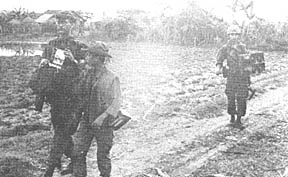 |
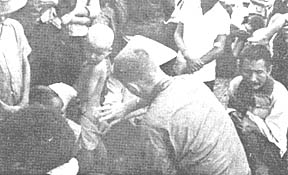 |
| PSYOPS - A psychological operations team working with the 4th Battalion, 9th Infantry on a cordon and search operation uses a loudspeaker to move the villagers from their homes to a central location. They then played information tapes and gave leaflets to the villagers. | MEDICAL AID - Medics of the 4/9 Manchus treat the Vietnamese villagers as other soldiers search the village for Viet Cong suspects and supplies. |
 |
 |
| SEARCH - An engineer attached to the Manchus moves a minesweeper over a haystack to detect Viet Cong supplies. | SOCCER - Infantrymen of the 4th Battalion, 9th Infantry play a game of soccer with the Vietnamese children. The village was being searched for Viet Cong suspects and enemy supplies. |
Page 4-5 TROPIC LIGHTNING NEWS July 29, 1968
Tropic Lightning’s Battle-Tired Soldiers
Bid Farewell To
Their Commander
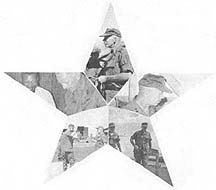 |
 |
Major General F. K. Mearns is scheduled to end
his tour of duty as Commanding General of the 25th Infantry Division, on August
3, 1968.
Since his arrival last August, he has led Tropic Lightning soldiers
through operations Waimea, Kunia, Atlanta, Saratoga, Yellowstone, Camden, Quyet
Thang, Wilderness, Toan Thang I and currently, Toan Thang II.
General Mearns is known best by his soldiers who saw him in the
field with them, talking to them, listening to their first hand accounts of
their battles and giving them his personal guidance and encouragement.
Under General Mearns’ command, the Tropic Lightning Division
compiled a highly successful combat record and at the time of his departure
stands as a true champion on the battlefield.
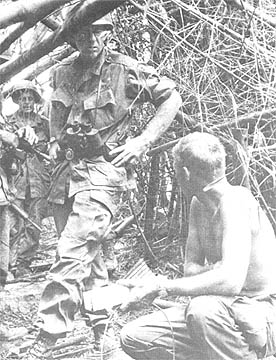 |
MAJOR GENERAL MEARNS stops in the field and questions a soldier who is about to set an explosive charge to destroy an enemy bunker complex. Maj. Gen. Mearns has spent countless hours visiting his men in the field. He continually concerns himself with their welfare and comfort. |
| EVEN A GENERAL must take time to relax and enjoy himself. The moment captured on film above was one of these lighter moments. Maj. Gen. Mearns is seen congratulating the 25th Division’s former Chief of Staff, Colonel Jasper J. Wilson, on his birthday. |  |
 |
THE RESPONSIBILITY to lead 18,000 men in combat is never taken lightly. Above, General Mearns is seen conferring in private with Lieutenant Colonel Roy K. Flint, then Commander of 3d Battalion, 22d Infantry, in a temporary Command Post. |
| MANY distinguished guests passed through the division’s area of operations during General Mearns’ year in command. One frequent visitor and friend of the Tropic Lightning Division was the former commander of all U.S. Forces in Vietnam and now Army Chief of Staff, General William C. Westmoreland, pictured with General Mearns and 3d Brigade Commander, Colonel Kenneth E. Buell. | 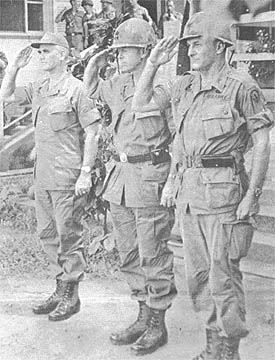 |
 |
A JOB WELL DONE is never forgotten. A familiar sight throughout the division area during the last year was that of General Mearns pinning a ribbon to a man’s chest, shaking his hand and commenting sincerely, “Well done!” |
Page 6 TROPIC LIGHTNING NEWS July 29, 1968
4/23 APC Men Pick A Position
2D BDE - With the Viet Cong’s extensive use of RPG rocket
launchers and recoilless rifles, armored personnel carrier (APC) drivers of the
4th Battalion (Mechanized), 23d Infantry, have adopted new driving techniques.
Prior to the enemy’s use of RPG rockets the 25th Infantry
Division soldiers drove their APC’s from inside the driver’s hatch.
But ask any driver where is the most vulnerable position, and he will very
likely point to the driver’s hatch.
With mines also a constant threat, “extended laterals” were
introduced and found quite successful. The laterals extend completely out
of the drivers hatch, and the driver can maneuver his APC while sitting on top
of the track, leaving the vulnerable driver’s compartment vacant.
The results speak for themselves as APC driver casualties dropped
almost 90%. As Lieutenant Colonel Clifford C. Neilson of Mobile, Ala., the
Tomahawk Battalion Commander, put it: “Extended laterals, being a product of
Yankee ingenuity, are an interesting adaptation of basic equipment to a
counter-insurgency environment.”
Using the principle of the extended laterals some of the drivers
adapted the “cowboy style.” Obviously familiar with rodeos or horse
racing the Tomahawks strapped ropes - ”reins” as they call them - to the
laterals and are able to make the track “gallop” at any speed and in any
direction without fear of the perils of the driver’s hatch.
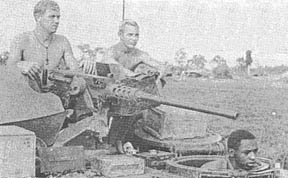 |
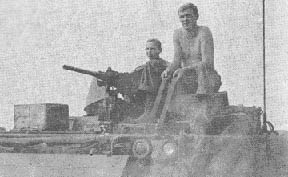 |
| THE OLD WAY - Specialist 4 Earl S. Bazemore of Baltimore, Md., drives a Tomahawk armored personnel carrier the old way as Specialist 4 Rox E. Goodwine (left) and Specialist 4 Michael D. Kizer look ahead for suspected enemy ambush sites. | COWBOY STYLE - Specialist 4 Rox E. Goodwine, of San Marcos, Tex., feels right at home driving an armored personnel carrier with “reins” as Specialist 4 Michael D. Kizer of Palestine, Tex., is poised for action. PHOTOS BY SP4 WALT CHAIKIVSKY |
 |
| WITH EXTENDED LATERALS - Specialist 4 Ronald P. Tramadeo, of Newington, Conn., an armored personnel carrier driver with the 4th Battalion, (Mechanized), 23d Infantry, prefers to use extended laterals as Specialist 4 James Faddis of Denver, Colo., looks ahead for mines in their path. |
Display Enemy Arsenal
CU CHI - A worthwhile place to visit at Cu Chi Base Camp is the
25th Infantry Division Museum. Located between the PX and the Ilikai East
Service Club, it is open daily from 8 a.m. until 11:30 a.m. and from 1 p.m.
until 5 p.m.
On exhibit is the bounty of war - the captured weapons and material
of the Viet Cong and the North Vietnamese Army. Some of the equipment
reflects other wars of other times and other nations. For example, on
display is a German 7.92 Light Machine Gun Type 26 with a swastika on the stock.
This weapon was first manufactured in 1926.
On exhibit are rifles, various types of machine guns, mortars, RPG
launchers, a 122 mm rocket with launcher, recoilless rifles, various types of
projectiles, clothing, field gear, a complete medical outfit, gas masks and
communication equipment which includes a portable typewriter.
Also, of special interest is the Viet Cong practice of
psychological warfare. The museum has a wide selection of Viet Cong
leaflets and posters.
Many units have contributed to the museum’s collection.
Some of the items, such as a Soviet Carbine SKS, captured Feb. 3, 1967, and a
CHICOM Sub-machinegun K .50, captured March 10, 1967, are also on display
highlighting the capturing unit.
4/23 Recon Makes Sure Charlie Will Go Hungry
2D BDE - Elements of the 25th Infantry Division have denied the
enemy another meal. While on a reconnaissance in force mission six miles
southeast of Tay Ninh, the 4th Battalion (Mechanized), 23d Infantry, commanded
by Lieutenant Colonel Clifford C. Neilson of Mobile, Ala., latched on to a
2,000-pound rice cache.
Sweeping through an abandoned rubber plantation, B Company made the
initial find. Sergeant Thomas R. Hall of Columbia, S.C., recalled: “I
saw a fresh trail leading into the brush so I decided to check it out.
There it was, sandbags filled with polished rice.”
The cache was camouflaged so it could not be seen from the air.
Fresh grass was loosely scattered on top of the sandbags leaving the sides
completely exposed. Further investigation revealed several 100-pound sacks
of rice very hurriedly hidden along a side of the ditch.
Private First Class Michael J. Carraher of Wellsville, Ohio,
surmised, “I suppose Charlie hid the rice very quickly here last night and
perhaps wanted to pick it up tonight. He’ll have to go hungry because
we’ve got it now.”
The cache was loaded on “Mojo,” an armored personnel carrier
that usually hauls caches for B Company, and sent to Tay Ninh where it will be
distributed to the civilian population under the Civic Action program.
MEDCAPs No. One
1ST BDE - Improvement marked the month of June for MEDCAP and Civic
Action Programs at the 25th Infantry Division’s 1st Brigade.
The 1st Brigade’s S-5 section, under Major Arthur Seabrook of
Charleston, S.C., completed 83 MEDCAPS in Tay Ninh Province, 20 more than in
May. Medical teams treated 9,738 persons.
On the civic action side, emphasis was placed on the schools of the
province. Two additional classrooms were built at Long My School while the
walls of other classrooms were repaired. Construction of a fence for the
school was also undertaken.
At Long Hoa School, classrooms were revamped and desks were built
or repaired.
Major Seabrook utilized the 25th Infantry Division Band during the
month. The band landed in Tay Ninh from Cu Chi and were driven to the
village of Cao Xa. At this Catholic refuge village the band held a concert
and the 1st Brigade conducted a MEDCAP.
Page 7 TROPIC LIGHTNING NEWS July 29, 1968
The Clan Fires Off 400,000th Round
CU CHI - The 400,000th artillery round “fired in anger” by the 3d Battalion,
13th Artillery, The Clan, since its arrival in Vietnam in April, 1966, left the
tube and sped on its way in a ceremony at Battery D in Cu Chi Base Camp.
The Clan provides general artillery support for the Tropic
Lightning Division, and this it has done with distinction. During May,
30,690 rounds were fired, a record number, and 187 members of the battalion were
decorated for valor or service.
With three batteries of M109 self-propelled 155mm howitzers, and
one self-propelled eight inch battery along with Headquarters and Service
Battery, the battalion has supported virtually every unit in the 25th Infantry
Division.
Over 70 battery moves have been made in the last, crucial six
months, from Katum to Tan Son Nhut. The Clan has provided the comforting
sounds of man-made thunder over the rice paddies and jungle of the 25th
Division’s area.
The 400,000th round, an eight-incher, was fired with charge 1,
green bag, fuze quick on the command given from the battalion’s adjutant
Captain Michael J. Lawn Jr.
| Story And Photos By SP4 Karl Gutknecht |
|
|||
|
|||
|
A Mudhole Stops Slippery Suspect
1ST BDE - While securing a vital bridge along Highway One, 6 miles
northwest of Saigon, the Recon platoon of the 4th Battalion (Mechanized), 23d
Infantry, came in contact with a slippery suspect.
Private First Class Leonard J. Lipperado of Monroe, Mich., was on
guard near an armored personnel carrier (APC) when he noticed someone lurking in
the area of his claymore mines. He immediately awoke Specialist 4 Fred E.
Bunge of Alhambra, Calif., who was sleeping on the APC. “Fred, wake up,
wake up. I saw someone fooling with our claymores,” Lipperado whispered.
The 25th Infantry Division soldiers observed the lurking figure
dash behind a hootch where about a minute later a man emerged from the hootch
and sat on a chair. Bunge, a veteran of over 18 months in country,
informed his platoon leader, First Lieutenant George W. Vessell of Hilo, Hawaii
who instructed them, “Bring that man to me.”
Cautiously the two Tomahawks approached the suspicious man and in
broken Vietnamese told him to come along with them. Immediately the
suspect made a quick move to escape, but slipped into a big mudhole.
“We had trouble holding him not because he was physically
stronger but simply because he was covered with slimy mud,” said Bunge.
They finally got a firm grip on the suspect and brought him to Vessell. He
was interrogated and turned over to the battalion’s intelligence officer the
next morning.
Cong Attack 2 ARVN Outposts
1ST BDE - A Viet Cong rocket and ground attack on two Army of the
Republic of Vietnam (ARVN) outposts, south of Trang Bang on Highway One was
beaten back by Vietnamese soldiers reinforced by elements of two 25th Infantry
Division battalions.
The outposts at Thi My and Phu Kap came under heavy RPG and B-40
rocket attacks at 1:25 a.m. A ground attack was mounted on the Popular
Force soldiers at Thi My. The Viet Cong kept up their mortar and rocket
barrage as they advanced on the outpost.
Troop C of the 3d Squadron, 4th Cavalry, and Company A from the 2d
Battalion, 22d Infantry moved through the early morning darkness to support the
outpost under attack.
Contact was broken at 4 a.m. as the enemy fled leaving nine of his
dead behind. One enemy suspect was detained, and four AK-47 rifles and
four B-40 rocket launchers were captured by the Allied troops.
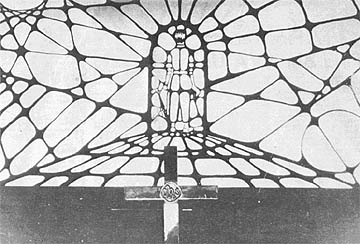 |
SOLDIER OF PRAYER - The 25th Infantry Division’s Memorial Chapel now has a colored plexiglass picture window. Portrayed is a soldier standing on top of the world with a helmet in his right hand and an M-16 rifle in his left hand. The window was painted by Private First Class Richard McDowell, a combat artist from Los Angeles, Calif. McDowell calls the window “The Soldier of Prayer” and has written a poem about it: “You too have your faults/ You stand on your world/ You must move the hearts/ Of those who look at you/ You will stand for something/ Which could be different/ From every angle/ You, with meditation and prayer/ Can make a soldier of prayer.” (PHOTO BY PFC TOM QUINN)
Page 8 TROPIC LIGHTNING NEWS July 29, 1968
Unit Of The Week
1/8 Has Vital Mission; Devastating Fire Support
 A close look at the unit crest will reveal the words, “Audacieux
et Tenace” on the scroll. The words mean “Bold and Tenacious,” taken
from the mottos of the 5th and 6th Artilleries, regiments from which the Eighth
was formed.
A close look at the unit crest will reveal the words, “Audacieux
et Tenace” on the scroll. The words mean “Bold and Tenacious,” taken
from the mottos of the 5th and 6th Artilleries, regiments from which the Eighth
was formed.
Organized on July 7, 1916 at Fort Bliss, Texas, the Automatic
Eighth was assigned to the Seventh Division. The unit was deployed in
France during World War One, but the Armistice was signed before the unit ever
saw combat.
The Eighth returned to the States, and was assigned to the Hawaiian
Division in 1921. Here it remained until 1941, when reorganization found
them with the 25th Infantry Division.
Then came World War Two. Island hopping throughout the
Pacific theater, the Eighth took three Campaign Streamers.
The war over, the Eighth settled down to the business of occupation
duty in Japan. This lasted until Korea opened up. Ten campaign
streamers were taken in Korea, as the Eighth joined the 25th Division in the
north. Seven unit citations were awarded to the Eighth in Korea.
Here is where the unit’s namesake, “Automatic Eighth,” came
to be. While escorting prisoners to the rear, the captured Communists
stopped. When guards ordered them on, the POW’s stated that they just
wanted to see this “new automatic artillery” that had been shooting at them.
The Automatic Eighth expended nearly half a million rounds in
Korea. This was a prelude to its present role in Vietnam; bringing the
wrath of devastating fire upon the enemy.
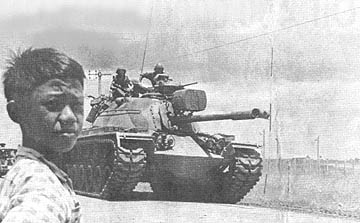 |
THIS YOUNG VIETNAMESE boy, like all the young American boys back home, looks to you to help decide the future. Exercise your right to help determine tomorrow’s decisions - send for your absentee ballot today. (Photo by A.J. Sullivan) |
Tomahawks Search, Probe; Find Sunken “Treasure”
1ST BDE - A constant month-long vigil over Tan Son Nhut air base by
the 4th Battalion (Mechanized), 23d Infantry has been highlighted by finding a
sunken rocket and mortar cache.
The Tomahawks have been charged with the mission of keeping the
Communists away from the Allied air base.
By day they make eagle flights to suspected VC strongholds; and by
night they search surrounding areas for enemy rocket and mortar launch sites.
Success traveled with the Tomahawks as intelligence reports
suggested one area where the rockets were being smuggled in. Company C
made an eagle flight into the area, eight miles northwest of Saigon. They had
walked through the swamps and canals for about 1,000 meters when suddenly they
spotted a fresh sampan trail going through the swamp.
“I’ve got a strong hunch this is it,” said Company Commander
First Lieutenant Gennero Mellis, from Mt. Vernon, N.Y. There they were;
three sampans submerged in the swamp.
From the air, Lieutenant Colonel Clifford C. Neilson, of Mobile,
Ala., Battalion Commander, spotted another sampan about 50 meters from the other
three.
The excavation began as the Tomahawks literally had to dive under
water to retrieve the cache. The prize consisted of 10 122mm rockets with
warheads, nine 122mm rocket fuses, 82 rounds of 82mm mortars, 24 cans of
primers, 12 cans of fuses for the mortars, and more than 5,300 rounds of AK-47
ammunition.
|
IF YOU’RE VISIT THE NEW Open: Mondays - 1300 to 2200
|
3/17 Fire Teams Find Big NVA Unit
1ST BDE - B Troop, 3d Squadron, 17th Air Cavalry light fire teams,
each consisting of one OH-6A scout helicopter and one UH-1C weapons helicopter,
were working 15 miles northwest of Saigon supporting the 25th Division in
response to an intelligence report that an enemy unit of unknown size was
present.
With gunships giving support and cover, the scout helicopter
descended to tree top level to search the area. It was soon determined
that a unit of approximately 500 strong, equipped with AK-47’s, RPG rocket
launchers and some .50 caliber anti-aircraft weapons were hidden among the tree
lines and canals.
One scout helicopter, piloted by Captain Michael C. Vecellio,
surveyed a tree line so effectively by fire that one NVA wounded in the leg and
arm came out of the woodline with his arms over his head. With the
gunships giving cover, PSG Kraemer, the observer in the scout ship, motioned the
man into the clearing for pick up.
The pick up was made by a gunship and the wounded NVA was given
medical treatment.
In little more than an hour and a half the detainee was flying over
the area in a speaker equipred aircraft urging his comrades to follow his
example and turn themselved in also. (From I.O. 1st Aviation Brigade)
| ON TARGET - A 155mm Howitzer is engulfed in smoke as Battery C, 3d Battalion, 13th Artillery fires in support of 25th Infantry Division troops fighting a Viet Cong force near Cu Chi. (PHOTO BY SP5 ROGER C. ERPENBECK) |  |
Thanks to
Don Casteel, 2nd Bn., 14th Inf. for sharing this issue,
Kirk Ramsey, 2nd Bn., 14th Inf. for creating this page.
This page last modified 8-12-2004
©2004 25th Infantry Division Association. All rights reserved.